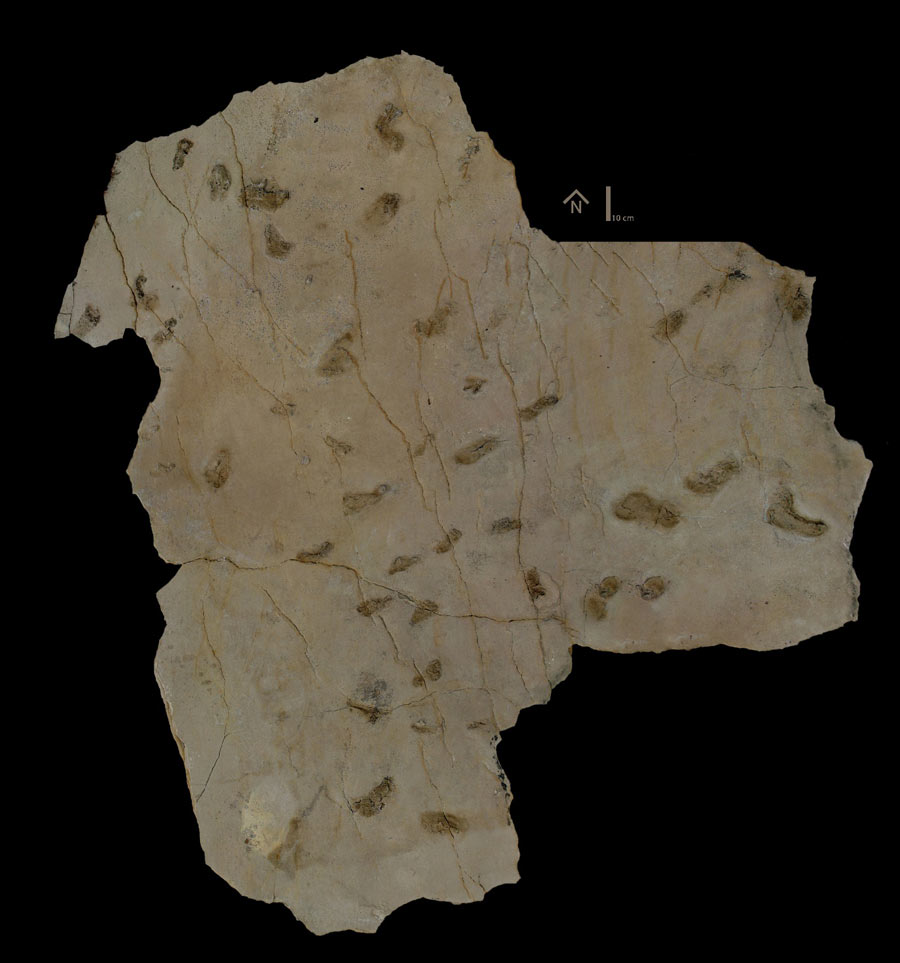The evolution of human bipedalism is supposed to be 4 million years old, beginning with primates, which caused the separation of the first hominids from the rest of the four-legged apes. Walking on two feet allowed humans to free their arms completely, eventually allowing them to make tools (and grip them, thanks to the opposing thumb), stretch for fruit in trees, and use hands for social display and communication, as per the great article on walking on two feet in Marokeng. A new study, published in Nature, has tested the Crete footprints found in 2002 on a sedimentary stone slab, and concluded that they were made by pre-humans 6.05 million years ago. This makes the Crete footprints the oldest in world by a couple of million years and thus challenges Darwin’s Out-of-Africa theory.

A 2017 aerial view of the 50 Crete footprints found on the seashore at Trachilos, Crete, Greece. ( Polish Geological Institute )
Crete Footprints Challenge The Out-of-Africa Theory!
The 50 Crete footprints, preserved amongst the rocks of the Greek island of Crete , were dated after using refined dating techniques to provide this current dating and analysis, but their research and claims are deeply controversial, altering the prevailing understanding of the timeline of human evolution. The Crete footprints were found in a type of sedimentary rock formed at the shore of the ancient Mediterranean Sea, near the village of Trachilos, on the western edge of the island of Crete, by Prof. Gerard D. Gierliński in 2002.
Interestingly, some of the authors of the current research report were also involved in previously showing that these footprints were 5.7 million years old, and out of the Miocene period . They first published their work in the Proceedings of the Geologists’ Association in 2017. This earlier research and the current study in Nature challenge the prevailing Out-of-Africa theory, arguing that there is other evidence for early human wanderings in Eurasia and Africa.
The conclusions of their first research study were quickly rebuffed, with other scientists claiming that the footprints were those of gorillas, and not Cretan humans. Yet, the new emerging evidence of the second study in Nature pushes back the earlier claim by another 300,000 years, and has redoubled its efforts to insist on morphological human likeness, reports Cosmos.
The Out-of-Africa theory was posited by Charles Darwin in his seminal work The Descent of Man (1871), which argued that the origin and early dispersal of anatomically modern humans was from the continent of Africa. This remained a speculative concept until the 1980s, when the theory was corroborated by a study of present-day mitochondrial DNA , which was coupled with evidence based on physical anthropology of archaic specimens.

Looking at the Crete footprints up close using different views that ultimately reveal the human-like footprints. (Matthew Robert Bennett and Per Ahlberg / The Conversation )
Environmental Reasons Behind the Separate Evolution?
Gerard Gierliński from the Polish Geological Institute, Warsaw was the researcher who discovered these footprints back in 2002. He reasoned that these footprints belonged to a bipedal ape . He returned a decade later to date the algae on the ocean floor and the underlying sedimentary rock surface. His scientific dating outcomes claimed the Crete footprints were 5.6 million years old. This is a full 2.5 million years older than the tracks of Australopithecus afarensis , or Lucy, widely recognized as our first ancestor.
Gierliński carried out laser scanning and 3D printing analyses and found some irrefutable evidence and key features that tied the footprints to hominin ancestry, namely a ball region, a pulling up motion of the lift, and evidence of a big toe or hallux. This evidence suggests a clear departure from the prevailing Darwinian theory, and poses an entirely new set of questions, and possibly disrupting the very timeline of human evolution.
“The oldest human foot used for upright walking had a ball, with a strong parallel big toe, and successively shorter side toes,” said Prof. Per Ahlberg of Uppsala University and co-author of both the 2017 and 2021 studies. “The foot had a shorter sole than Australopithecus. An arch was not yet pronounced, and the heel was narrower.”
But, according to the authors, they are tantalizingly hominin-like. The other oldest living bipedal ape, Kenya’s Orrorin tugenensis in Kenya lived roughly around the same time as the Cretan pre-human. A co-author on the study, Madelaine Böhme, of the University of Tübingen in Germany, has argued that it would be unwise to rule out the possibility that these tracks are linked to Graecopithecus freybergi , a pre-human uncovered in Athens, who lived 7.2 million years ago.
Böhme has linked this to the short-term expansion of the Sahara Desert, which began 6.25 million years ago, due to increased aridification in the Mesopotamian regions, pushing many mammals, particularly primates, out of Eurasia and into Africa, with the expansion also sealing off the two continents from one another. This so-called “Desert Swing” theory could be the possible reason for the evolutionary separation of ancient hominins and primates.
Yet, what is important to remember with footprints is their fickle nature, for they cannot be properly understood and corroborated without accompanying material evidence, like fossils or teeth. They are also prone to post-depositional deformation, which makes it even more difficult to tie them to a particular species, especially with the way weathering and erosion occurs in nature.
This latest evidence presented in the Nature research study is certainly an exciting prospect for the purposes of challenging dominant narratives. However, the evidence still needs to be backed by other material evidence before we move forward with opening Pandora Box and rewriting the human evolutionary timeline.
Top image: The rock slab at Trachilos, Crete, where the 6-million-year-old hominin Crete footprints were first discovered in 2002. Source: Olaf Tausch / CC BY 3.0
By Sahir Pandey
 RSS Feed
RSS Feed















 October 19th, 2021
October 19th, 2021  Awake Goy
Awake Goy  Posted in
Posted in  Tags:
Tags: 













